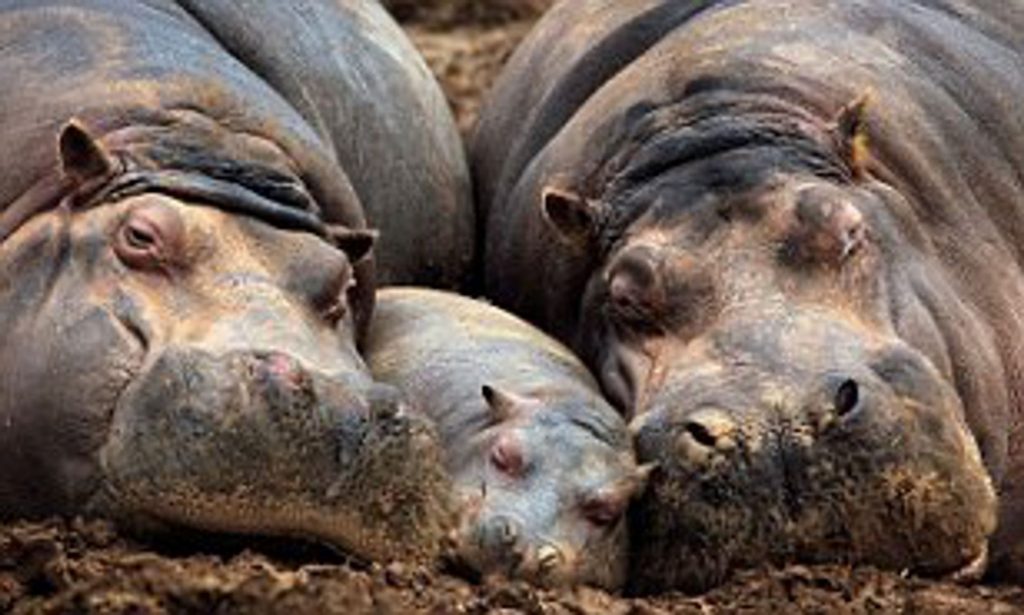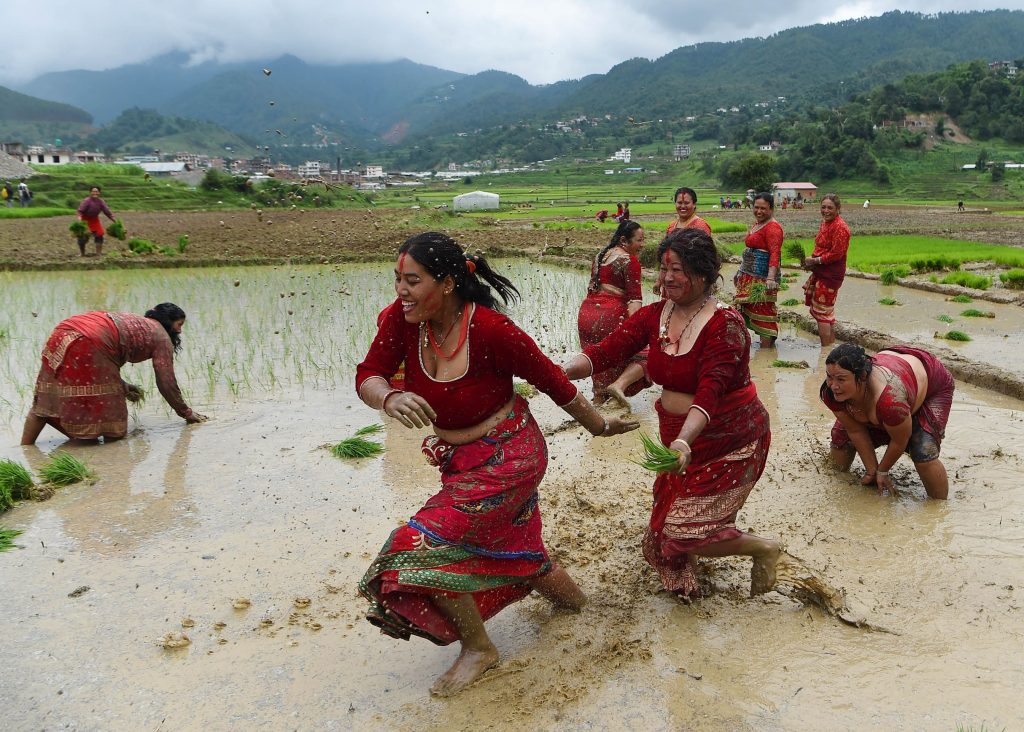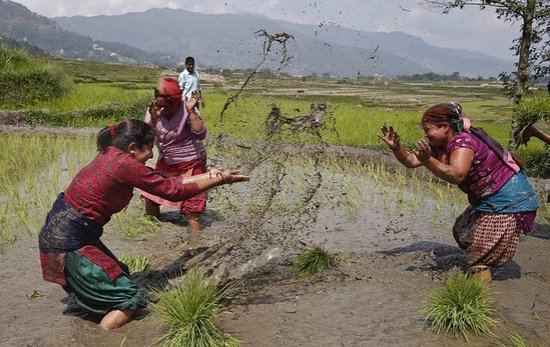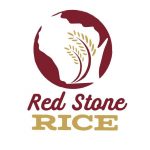
Written by Hippo (a hippopotamus) and Al (a bird)
Red Stone Rice LLC was founded by Michael Schläppi, a professor of biology at Marquette University. Funded by grants from Marquette University and the US Department of Agriculture, his research identified a high-yielding Southern Russian rice variety that could withstand the colder weather in Wisconsin. The first trial was grown on a rooftop garden at the university, and in 2017, one acre of rice paddies was established at the Mequon Nature Preserve. In partnership with the Fondy Food Center, Red Stone Rice is cultivated using sustainable organic practices, without any input of agrochemicals, by flooding the paddies with water from a nutrient rich pond. Red Stone Rice is thus locally sourced: grown, harvested, and packaged 20 minutes away from downtown Milwaukee!
Al and I recently volunteered at Red Stone Rice, the first, and so far, the only, rice paddy in Wisconsin.
Why in the world would a hippo and bird do such a thing, you may rightly ask. Well, rice grows in wetlands and wetlands are full of mud. I hadn’t had the chance to wallow in the mud since we left the savanna. Hence, I could not wait. While I was supposed to be folding up landscape fabric – which was like folding 100-yard-long bed sheets – I accidentally ended up with my backside in the mud on more than one occasion, and may have stayed there longer than necessary. But Al and I are trying to learn as much as we can about human food growing, so we had been waiting for this opportunity ever since we met Michael selling the rice at the Milwaukee Winter Farmers Market.
Before our visit, the seeds had been started in trays and put into what might be called an incubator. They had been moved to the hoop house (a hoop-shaped greenhouse) and were about two inches tall. Al and I helped weed one of those trays.

Rice Seedlings in the hoop house 
Michael at the pond
“There were jillions of trays, all needing to be weeded,” Al said. “And they also have to till the field, level the ground so the water doesn’t settle in the low spots, plant the seedlings in the field, and so much more. What a lot of work!”
Michael said it has traditionally been a community effort with neighbors helping neighbors. Much more than just physical sustenance, rice growing has connected generation with generation, individuals with their communities, and humans with the sacred Earth.
For that reason, Red Stone Rice has special meaning to the Milwaukee Hmong population. Many fled Laos at the end of the Vietnam war and left behind the traditions and culture of growing rice.
“I was six when I came from Laos,” said Mayhoua Moua. (Her dad and uncle worked for the United States to rescue prisoners of war in Vietnam, so when communism came into the country in 1975 the family had to flee.) “I have never grown rice – never been this close to a rice paddy before. It’s reconnecting me to my roots. It’s wonderful.”
“And it is connecting me to the mud too” I added, “which is part of my culture and my good memories. Since they don’t use agro-chemicals, I can join the frogs – yes, there are frogs – and wallow to my heart’s delight!”

“Humans must like the mud as much as hippos do,” I said to Al. “Just look at these women from Nepal in the rice paddy:”
“And here’s a story from India:
In the past, the annual harvest meant much more than gaining a sacred cellar full of rice, it was also the season of festivities and games. There was societal harmony, since the whole community joined hands to thank Nature.
Children either rendered a helping hand or leapt into the wet fields to play. In the rhythm of monsoon showers, their bodies soaked in mud, farmers belted out upbeat folk songs while carrying bundles of paddy, which their dancing legs would stomp on later at night, separating the grains.
We have fond memories of sleepless nights during the harvest seasons, of enjoying fun-filled evenings spent interacting with local men, and of sumptuous rice kanji savoured with seasonal delicacies specially prepared on this occasion.
A significant item of the 24-hour-long festival on September 16, 2017, is playing in a watery paddy field after the harvest. A group of tourists were taken to the wet fields, where they played with locals. Those youngsters leapt into the wet land and had a blissful mud bath. It was unbelievable fun for them— they went on for five hours.
Excerpted from the article “A song in the rice fields” by Das Sreedharan, published 26 August 2017 in the New Indian Express.
“What a great time!” I said. “That must be why rice is a staple food for more than half of the human population.”
Suddenly, Michael turned on the irrigation system and water from the pond whooshed out and flooded the rice in the hoop house. He said we get enough rainfall here that, even when used for irrigation, the water level in the pond remains stable.
In many places, though, Al and I learned, irrigation for rice, even organically grown rice, is a big problem. Use of groundwater for not only rice, but wheat, corn, cotton, and other crops is depleting vital groundwater resources across the globe. One of the biggest causes of disappearing groundwater has been the international food trade – a good reason to buy local food.
On America’s high plains, crops in early summer stretch to the horizon: field after verdant field of corn, sorghum, soybeans, wheat and cotton. Framed by immense skies now blue, now scarlet-streaked, this 800-mile expanse of agriculture looks like it could go on forever.
It can’t.
The Ogallala Aquifer, the vast underground reservoir that gives life to these fields, is disappearing. In some places, the groundwater is already gone. This is the breadbasket of America—the region that supplies at least one fifth of the total annual U.S. agricultural harvest. If the aquifer goes dry, more than $20 billion worth of food and fiber will vanish from the world’s markets. And scientists say it will take natural processes 6,000 years to refill the reservoir.
https://www.scientificamerican.com/article/the-ogallala-aquifer/
Al and I have been invited back to play in the mud help with the planting in June.
“If Michael has not planned a harvest festival yet, maybe we can encourage him to do so,” added Al.
“Good idea!” I said. “Anything else should we tell them, Al?”
“Just buy it!”
Where can i buy Red Stone Rice?
- At the website https://redstonerice.com/shop/
- At The Glass Pantry, the new, zero-waste store that we wrote about here.
- At Outpost Natural Foods
- At Milwaukee Winter Farmers Market



